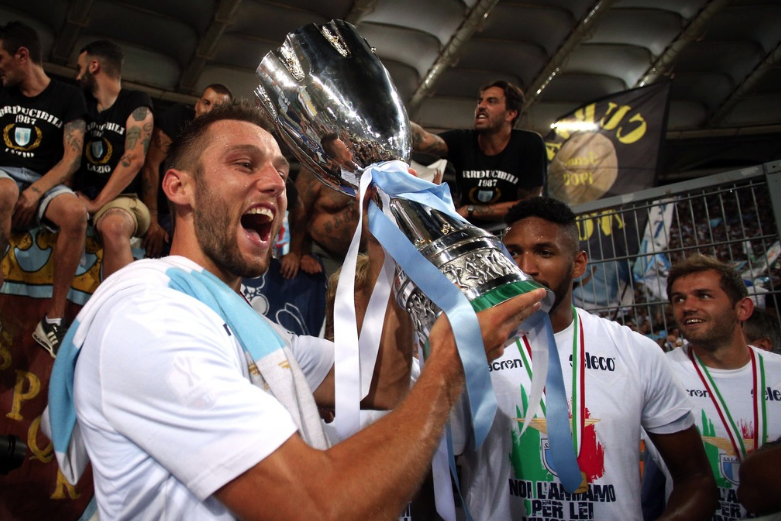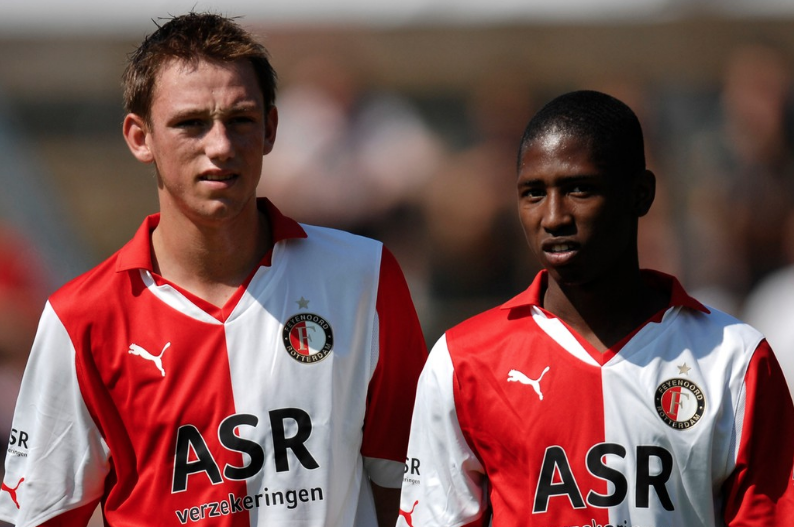Around this time, there is always talk about great players who won’t be at the tournament. In this case, the likes of Frabegas, Sane, Nainggolan and others come to mind, but we will focus on the Dutch stars missing out.
The first one in the series, is Stefan de Vrij. Probably our best player with the least media exposure.
Here’s a guy who scored at a World Cup, played four seasons in the top of Italy (as a defender) and who was (is?) on many a wishlist for big clubs all across Europe.
He would be “the least likely to succeed” in Feyenoord’s year book if Feyenoord would have a year book…
While the 26 year old gets his top transfer this summer (5 seasons at Inter Milan), our memories go back to 2011, when the anger, despair and frustration seaps from the Feyenoord stands on to the pitch, where a young De Vrij makes his way to the tunnel in tears. Feyenoord loses at home 0-1 vs De Graafschap and is 14th in the Eredivisie. In a period where the club from Rotterdam gets beating after beating, it’s players like Wijnaldum, Fer and Castaignos who symbolise the hope in Rotterdam. But Stefan de Vrij is the ugly duckling. Always needing to swim upstream but drowning on that January night.
De Vrij, born ten kilometers from Rotterdam in Ouderkerk aan den IJssel (basically “Old Church on the river IJssel”). A little village. Where indeed the church rules. On Sunday, the shops are closed, no football club is in action and where Stefan de Vrij grew up a shy lad.
He makes his way to Feyenoord’s youth system. All the experts have seen it. There is a right footed defender now at Feyenoord, who will most likely make it to the first team, make it into the Dutch team and is set for greatness. But they’re not talking about De Vrij, but about the six months younger lad Jeffrey Bruma, signed from Excelsior Bruma is a city kid. Bit mouth, and always ready to win an argument with a fight. A big contrast with the village kid from Ouderkerk: shy and down to Earth.
It’s hard for Stefan. Young Jeffrey is invited to play in the older teams, in place of De Vrij. Bruma is also picked for the different rep teams of their age group, and De Vrij is not. In 2006, Chelsea shows up, with a bag of money and promises.
A young De Vrij in his typical Dutch little village….
Feyenoord is not happy, but for De Vrij, this is good news. But, he still isn’t the go to player for the central defenders role. Feyenoord also has Karim Rekik. He’s also younger than Stefan but has the personality of a leader and draws most of the attention. Luckily for De Vrij, also the attention from Manchester City. So Rekik leaves too and it’s the decisions made by others that will influence Stefan’s career. Still he is a question mark.
Feyenoord protects its big talents with early contracts. The fact that De Vrij gets his first contract when he turns 17 years old is a typical sign. Only months later, he makes his debut in the first team.
In 2014, Lazio Roma pays millions for the defender and at that time, it seems very logical. He played 150 matches for Feyenoord, played 20+ international games, won a bronze World Cup medal, but that De Vrij would become one of Europe’s top defenders…no one could know….
And Stefan now, the cosmopolitan defender in Rome, next stop Milan
In Stefan’s career, it seems the decisions by others were key for him. There were not a lot of coaches who recognised his qualities and said: right! He’s my man! Look at De Vrij’s debut season under Mario Been in 2009.
De Vrij is brought into the squad as the last player that summer. And he would finish the season as starting player. Because right back Dani Fernandez gets a serious injury. His replacement Kelvin Leerdam, gets a serious injury. His replacement Bandjar…you guessed it…gets injured. Been doesn’t get more money to sign another right back, so De Vrij gets the job.
Mario Been uses De Vrij as right back and is quite clear in the media and press conferences, that this is an emergency move. Been also states that if Bruma wouldn’t have gone to Chelsea, he would have had the spot.
De Vrij doesn’t impress as right back. But the criticism is mild, as expectations about him were never high and everyone at Feyenoord knows it’s not his spot.
He does get a chance to play centrally. For the away game vs PSV Eindhoven, Ron Vlaar is injured, so De Vrij gets the spot. Feyenoord loses that match 10-0. The biggest defeat ever and the beginning of the end for Mario Been. The match at home vs De Graafschap is the real low for De Vrij. Feyenoord falls to the 14th spot and De Vrij is crying his heart out in the dressing room. Been made a public call to his management to free up funds for defensive reinforcements. The answer is: No!
Mario Been now: “He was a very quiet and sweet lad. And he struggled against really tough strikers and quick and agile wingers. He’s not a born athlete, he is not a quick mover but when he played centrally, you could see him improve. Centrally, his build up pass and positioning became apparent as strengths. Stefan does see situations earlier than others. That is his strength. And Vlaar was a great mentor for him, he learned a lot from Ron.”
De Vrij started to work on himself, more and more. So much so that Koeman took his captains band, when he found out Stefan was in the gym without the consent of the Feyenoord medical staff. He kept on searching to better himself and develop, mentally, physically, mentally. He studied Neurolinguistic programming for instance, to focus better and even worked with renowned guru Wim Hof, the Iceman, to learn about the health benefits of ice-baths and breating techniques. And to this day, he analysis every match he plays via FaceTime with the tactical analysis company Your Tactical Analyst.
No more Mr Nice Guy
De Vrij as the symbol of a club, almost dead. In every aspect. In a sports-sense and financially. But also the symbol of the resurrection. Ronald Koeman comes and he uses De Vrij centrally, first next to mentor Vlaar and later next to Joris Mathijsen. Koeman gives him the #3 jersey and gives him confidence. In the 2013/14 season, he plays centrally with his mate Bruno Martins Indi, a lad he played with in all his youth teams and a close friend.
Feyenoord is back at the top, and finishes just 4 points behind Ajax. De Vrij plays a strong World Cup under Van Gaal and bang: his move to Rome is there.
And now, after 4 seasons there, he will make his next step in a career propulsed forward by coincidence and circumstance. De Vrij’s character and personality pulled him through. He didn’t get swimming lessons, or training wheels, he was just pushed in and told to fake it until he made it. And he made it.
And it was Feyenoord’s bad spell that create this top defender. In any other club, De Vrij would have been replaced. Feyenoord had to use him and grew, because he was allowed to fail. He learned and developed as a result of all his mistakes.
And this made him a top defender. He’s not the strongest, not the quickest, but he reads the game ever so well, and is strong positionally. And he is able to place the ball on your necktie over 50 yards. He’s hardly ever in panic and never got a red card in his career.
This season, he also was the most scoring defender in the Serie A and was #3 in the list of top ball retainers, behind Torreira and his new colleague at Inter Skriniar.
There might be a lesson to be learned from his career trajectory. Let’s see how El Ghazi, Adam Maher, Bazoer and others go in the years to come…
That goal!








